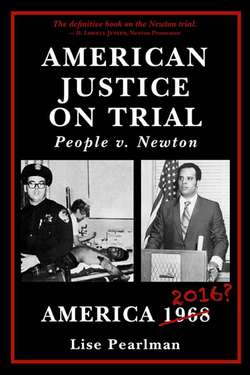AMERICAN JUSTICE ON TRIAL

Реклама. ООО «ЛитРес», ИНН: 7719571260.
Оглавление
Lise Pearlman. AMERICAN JUSTICE ON TRIAL
American Justice on Trial 1968–2016
Comments on the book from trial participants and observers
Praise for The Sky’s the Limit:
AMERICAN JUSTICE ON TRIAL. PEOPLE v. NEWTON
CONTENTS
INTRODUCTION
1. FREE HUEY NOW!
2. OAKLAND — THE MAKINGS OF A RACIAL TINDERBOX
3. THE PANTHERS’ ROOTS
4. TAKIN’ CARE OF BUSINESS
5. THE DEFENSE TEAM
6. WHO DO YOU TRUST?
7. HONKIES FOR HUEY
8. THE SMELL OF REVOLUTION
9. CLIENT OR COMRADE?
10. POWER TO THE PEOPLE
11. THE QUEST FOR A JURY OF HIS PEERS
12. A MINORITY OF ONE
13. ON TRIAL — NEWTON OR AMERICAN SOCIETY?
14. THE BURDEN SHIFTS
15. THE DAY OF RECKONING ARRIVES
16. AFTERMATH
17. WINNING NEWTON’S FREEDOM
18. TO WHAT END?
19. REVOLUTIONARY SUICIDE
20. THE ARC OF THE MORAL UNIVERSE
EPILOGUE
SOURCES. Individuals:
Special Collections:
Private Collections:
Principal Newspaper and Periodical Sources:
Books:
Web Sources:
Journal Articles and Pamphlets:
ENDNOTES
ABBREVIATIONS USED IN THE NOTES
AMERICAN JUSTICE ON TRIAL, 1968--2016 [Author’s Note]
INTRODUCTION
1. FREE HUEY NOW!
2. OAKLAND – THE MAKINGS OF A RACIAL TINDERBOX
3. THE PANTHERS’ ROOTS
4. TAKIN’ CARE OF BUSINESS
5. THE DEFENSE TEAM
6. WHO DO YOU TRUST?
7. HONKIES FOR HUEY
8. THE SMELL OF REVOLUTION
9. CLIENT OR COMRADE?
10. POWER TO THE PEOPLE
11. THE QUEST FOR A JURY OF HIS PEERS
12. A MINORITY OF ONE
13. ON TRIAL — NEWTON OR AMERICAN SOCIETY?
14. THE BURDEN SHIFTS
15. THE DAY OF RECKONING ARRIVES
16. AFTERMATH
17. WINNING NEWTON’S FREEDOM
18. TO WHAT END?
19. REVOLUTIONARY SUICIDE
20. THE ARC OF THE MORAL UNIVERSE
EPILOGUE
INDEX
A
B
C
D
E
F
G
H
I
J
K
L
M
N
O
P
Q
R
S
T
U
V
W
X
Y
Z
ACKNOWLEDGEMENTS
Отрывок из книги
As I write this, the nation is still reeling from multiple shocks in July 2016. First, as the month began, came yet two more videotaped incidents of police shooting to death black arrestees after many other such widely-publicized incidents over the previous several years. The day after the Fourth of July holiday, disturbing footage went viral of Baton Rouge police outside a convenience store firing repeatedly at 37-year-old Alton Sterling while two white policemen already had Sterling pinned face down on the ground. A day later, a thousand miles away in a suburb of St. Paul, Minnesota, the quick-thinking girl friend of Philandro Castile used her cell phone to capture a local policeman still waving his gun outside Castile’s car window as Castile lay bleeding to death seated beside her following a traffic stop. This graphic image was followed within days by breaking news of a horrific sniper attack on Dallas policemen who were monitoring one of many Black Lives Matter protest rallies prompted by the deaths of Sterling and Castile. Then, on July 17, 2016 came another attack, this time on Baton Rouge police.
The carnage and proliferation of demonstrations and hostile reactions in the aftermath have drawn renewed national focus to fractured police-community relations in cities across country, the very issue that gave rise to the Black Panther Party a half century ago. Indeed, the day after video footage went viral of Castile dying from gunshot wounds following a traffic stop, AlterNet reporter Alexandra Rosenmann drew a direct comparison to the sensationalized 1968 murder trial of Panther Party co-founder Huey Newton. Rosenmann titled her web article, “Gun Rights, Police Brutality and the Case of the Century: Philandro Castile’s tragic case of police brutality pulls one of the most famous cases back into focus.”1
.....
Less than three months after the profile of Huey Newton ran in The New York Times came headlines of an early morning shootout in West Oakland in which patrolman John Frey died and Newton and another police officer were severely wounded. Frey was the first officer killed by gunfire in Oakland in two decades. Were the Panthers signaling to inner city blacks across the country that the time had come for armed revolt? Sensing a great propaganda opportunity, the American Communist Party quickly offered to raise funds for Newton’s defense. A public relations battle soon followed, with the establishment press on one side and the underground press on the other, over who was the victim and who the aggressor, while the Panthers exploited the publicity to gain support for their revolutionary agenda.
Pioneering black media professionals like San Francisco TV reporter Belva Davis and print journalist Gilbert Moore, who covered the trial for LIFE magazine, found themselves caught uncomfortably in the middle. The Panthers’ 10-point program resonated with them even though they both disagreed with the Panthers’ extremism and glorification of violence. The Panthers soon began to attract wealthy leftist celebrities like Marlon Brando, Jane Fonda and Leonard Bernstein — among the elite later ridiculed by author Tom Wolfe as indulging in “radical chic” by embracing the Panthers’ cause. The implication was that these celebrities were naïve and silly, considering it trendy to dabble with extremists they knew little about. On the other side of the political spectrum, 1968 presidential candidate Richard Nixon focused on black militants as the target of his “Law and Order” campaign, vying with Independent segregationist George Wallace for the support of fearful white voters. The 1968 “Law and Order” campaign marked the start of the Republican Party’s famous “Southern Strategy” which has been the GOP’s electoral mainstay ever since.
.....